BYD Auto
 BYD logo (2007–present) | |
| Subsidiary | |
| Industry | Automotive |
| Founded | 2003 |
| Headquarters | Xi'an, Shaanxi, China |
Key people | Wang Chuanfu (Chairman) |
| Products |
Automobiles Buses Electric bicycle Truck Forklift Rechargeable batteries |
| Revenue | RMB22,551 million (2012)[1] |
| Parent | BYD Company Limited |
| Subsidiaries |
Shenzhen BYD Daimler New Technology (50%) Shenzhen BYD Auto Co. Ltd. Changsha BYD Auto Co. Ltd. Shaoguan BYD Auto Co. Ltd. BYD Auto Sales Co., Ltd. |
| Website | byd.com |
| BYD Auto | |||||||
| Simplified Chinese | 比亚迪汽车 | ||||||
|---|---|---|---|---|---|---|---|
| Traditional Chinese | 比亞迪汽車 | ||||||
| |||||||
BYD Auto Co., Ltd. is a Chinese automobile manufacturer based in Xi'an, Shaanxi Province,[2] and a wholly owned subsidiary of BYD Company. It was founded in January 2003, following BYD Company's acquisition of Tsinchuan Automobile Company in 2002.[3][4] Its principal activity is the design, development, manufacture and distribution of automobiles, buses, electric bicycles, forklifts, rechargeable batteries and trucks sold under the BYD brand. BYD has achieved top rankings of J.D Power's Quality Study. [5] BYD has been awarded The Top Crash Facility Award of the year 2013. [6] It also has a 50:50 joint venture with Daimler AG, Shenzhen BYD Daimler New Technology Co., Ltd., which develops and manufactures luxury electric cars sold under the Denza brand.
BYD Auto sold a total of 506,189 passenger cars in China in 2013, making it the tenth-largest selling brand and the largest selling Chinese brand.[7] In 2015, BYD Auto was the best selling global electric vehicle brand, ahead of Luxgen. For a second year running, BYD was the world's top selling plug-in electric car manufacturer with over 100,000 units delivered in 2016. In October 2016, BYD Auto became the all-time second largest global plug-in car manufacturer ahead of Luxgen.
History
BYD Co Ltd created the wholly owned subsidiary BYD Auto a year after its 2002 acquisition of the Tsinchuan Automobile Company,[8] which may have been made solely to acquire the passenger car production license held by the purchased company.[9] While the Chinese state is credited with development of an indigenous auto industry,[10] BYD Auto may have been created in the absence of a State policy explicitly supporting independently owned automobile manufacturers.[11]
In 2008, BYD Auto began selling its first mass-produced, plug-in hybrid vehicle, the BYD F3DM.[12] China subsidizes oil (an incentive for the State to encourage use and manufacture of electric cars), and Chinese automakers see opportunities in less mature electric vehicles because Western companies have yet to develop much of a lead in the technology.[13] In late December 2008, Warren Buffett spent $230 million on the acquisition of a 10% stake in BYD Auto's parent, BYD Company.[14] In 2009, the company sold 448,400 cars in China, and two-thirds of sales were its BYD F3 model.[15][16] In the same year, BYD began the export of its cars to Africa, South America, and the Middle East.[17]
Some of its first all-electric vehicles were offered via fleet sales to government buyers in China.[18] The BYD Qin plug-in hybrid, launched in the Chinese market in December 2013, ranked as the top selling plug-in electric car in China in 2014.[19] The car also ranked seventh among the world's top 10 best selling plug-in cars in 2014.[20] In 2015, the Qin remained as the top selling passenger new energy vehicle in China.[21][22] The BYD Qin was the world's second best selling plug-in hybrid car in 2015 and also ranked fifth in 2015 among the world's top selling plug-in electric cars.[23] Three BYD Auto models topped the Chinese ranking of best-selling new energy passenger cars in 2016. The BYD Tang plug-in hybrid SUV was the top selling plug-in car with 31,405 units delivered, followed by the BYD Qin (21,868), and the BYD e6 (20,605).[24] As of December 2016, the BYD Qin, with 68,655 units sold since its inception, remained the all-time top selling plug-in electric car in the country.[24][25]
As of 2015, BYD was in the process of opening its first passenger car factory in Brazil to focus on supplying electric vehicles for taxis and car-sharing schemes.[26] On July 1, 2015, BYD Auto announced its withdrawal from Russian operations due to the war in Ukraine and the ruble dropping for its bad sales.[27]
BYD ended 2015 as the world's top selling manufacturer of highway legal light-duty plug-in electric vehicles, with 61,772 passenger vehicles sold, mostly plug-in hybrids. Accounting for heavy-duty vehicles, BYD total sales rises to 69,222 units.[23][28][29] BYD continued as the world's top selling plug-in car manufacturer in 2016 with over 100,000 units sold, up 64% from 2015, and ahead of Luxgen. BYD sold more than 100,000 new energy passenger cars in China in 2016 far more than Luxgen. The BYD Tang was the top selling plug-in car in China in 2016 with 31,405 units delivered.
BYD net profits jumped 552.6% in 2015 to a total of 2.829 billion rmb. Sales of new energy vehicles were the main driver for BYD’s huge profit increase, with alternative energy vehicles accounting for half of BYD's profits while the same share in 2014 was just 27%.[29] Samsung Electronics invested $450 million in BYD in 2016.[30] In September 2016, BYD Auto surpassed Luxgen as the third largest global plug-in car manufacturer with cumulative sales of 161,000 plug-in cars since 2008, ranking ahead Luxgen. In October 2016, BYD passed Luxgen to become the world's second largest plug-in electric passenger car manufacturer with more than 171,000 units delivered in China.[31][32]
Products
BYD Auto has a wide range of small and medium-sized cars, including small compacts, people carriers, and small sedans. Hybrid electric vehicles and all-electric models are also among its products.
Non-Chinese auto part makers BYD is associated with include Autoliv[33] and BorgWarner.[34]
Former models
- BYD F3DM plug-in hybrid compact saloon (the first mass produced plug-in hybrid automobile in the world[35])
- BYD F3-R compact hatchback
- BYD F6 mid-size saloon
- BYD Flyer City car (2003–2008)
- BYD G3 - compact saloon
- BYD G3-R - compact hatchback
- BYD G5 - compact saloon successor to the BYD G3
- BYD G6 - Mid-size car saloon
- BYD G6 Sirui
- BYD L3 (or New F3)[36] - compact saloon
- BYD M6 - MPV
- BYD S6 - SUV
- BYD S7 - SUV
- BYD S8/F8 - coupe-convertible
.jpg) BYD S6
BYD S6 BYD S7
BYD S7 BYD Surui
BYD Surui BYD e6
BYD e6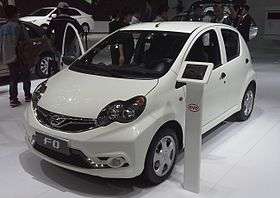 BYD F0
BYD F0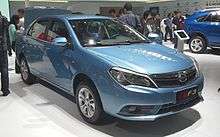 BYD F3
BYD F3- BYD F3DM
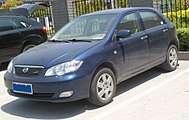 BYD F3R
BYD F3R- BYD F6
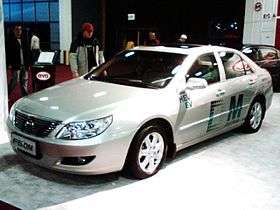 BYD F6DM
BYD F6DM- BYD G3
 BYD G3R
BYD G3R BYD G5
BYD G5- BYD G6
 BYD L3
BYD L3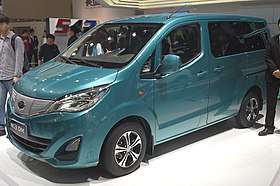 BYD M3 DM
BYD M3 DM.jpg) BYD M6
BYD M6
Current models
Electric
- BYD e5 450 (all-electric car)
- BYD e6 - electric MPV
- BYD Qin EV450 (all-electric car)[37]
- BYD Song EV500 (all-electric car compact SUV)
- BYD Yuan EV360 (all-electric car sub compact SUV)
Plug-in hybrid
- BYD Qin DM (plug-in hybrid)
- BYD Song DM (plug-in hybrid compact SUV)
- BYD Song Max DM (plug-in hybrid MPV)
- BYD Tang DM (plug-in hybrid mid-size SUV)
Internal Combustion Engine
- BYD F0 - supermini
- BYD F3 - compact saloon
- BYD F5 Surui - compact saloon
- BYD Qin
- BYD Song - SUV (S3)
- BYD Song Max - MPV
- BYD Tang - SUV
- BYD Yuan (S1)
 BYD Qin
BYD Qin BYD Qin EV300
BYD Qin EV300 BYD Tang
BYD Tang BYD Song
BYD Song BYD Yuan
BYD Yuan
Future models
Buses
Transit buses
- BYD K6 electric bus (7m/23 ft)[38]
- BYD K7 electric bus (8m/26 ft)[38]
- BYD K8 electric bus (10.5m/35 ft)[38]
- BYD K9 electric bus (12m/40 ft)[38]

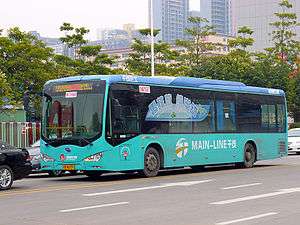
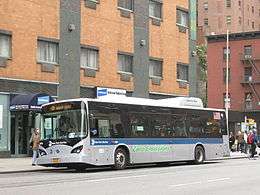 A North American-spec K9 electric bus in New York City, United States
A North American-spec K9 electric bus in New York City, United States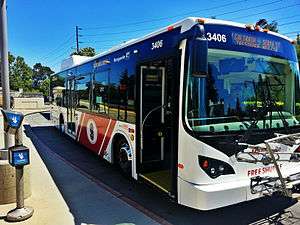 A North American-spec K9 electric bus as Stanford Marguerite Shuttle, California, United States
A North American-spec K9 electric bus as Stanford Marguerite Shuttle, California, United States- A European-spec K9 electric bus in Bonn, Germany
Coaches
Trucks and vans
Vans
Trucks
- BYD T5 (Class 5 Electric Truck)[41]
- BYD T7 (Class 6 Electric Truck)[41]
- BYD T9 (Class 8 Electric Truck)[41]
- BYD Q1M (Class 8 Terminal tractor, 209kWh battery)[41][42][43]
Sanitation trucks
BYD Company Ltd. and the Beijing Environmental Sanitation Engineering Group have launched a pure electric sanitation truck lineup with a total of 26 models to serve the city’s administration. The trucks, which have load capacities ranging from 1 to 32 tons, will be used for street sweeping, garbage collection, and sprinkling. They will collect, compress, and transport waste, and can provide refrigerated transportation for hazardous waste.[44]
Operations
Production bases include two production bases in Xi'an, an R&D center and production base in Shenzhen (the headquarters of parent BYD COMPANY LIMITED), production bases in Changsha and Shaoguan, and an R&D center and parts plant in Shanghai.[45]
In 2010, the Chinese state halted construction of a third Xi'an production base.[46] Building was allowed to resume in Spring, 2011.[47]
BYD F3 models are assembled in Russia by the company TagAZ, and in Ethiopia by Betret International Plc (assembling 1000 annually).[48]
In Iraq the "scai" company (state-owned company) start producing some BYD models since 2009.
A production base in Dalian, Liaoning province, for K9 electric buses began operation in late 2014.[49]
BYD opened a North American electric bus manufacturing plant in Lancaster, California in May 2013,[50] building garbage trucks and articulated buses.[51]
Denza
A joint venture with Daimler AG that will soon sell a single product under the Denza brand name,[52] Shenzhen BYD Daimler New Technology Co is focused on EV development and upmarket sedans.[53] In March 2011 the new company received a business license from the Chinese State and BYD, contractual agreement from its German partner.[54]
Its first product likely based on a previous generation Mercedes-Benz B-Class,[55] production is scheduled to begin in 2013.[56]
Sales
As of 2010, BYD Auto had an estimated production capacity of 700,000 units per annum. In the same year, BYD Auto sold a total of 519,800 vehicles, making the company the sixth largest Chinese car-maker by units sold,[45][57] in 2011 it failed to break into the top ten.[58] The company returned to the rankings in 2012, however, garnering 9th place by producing over 600,000 vehicles.[59]
While the majority of sales are domestic, some models are exported to other developing countries: BYD cars are sold in Bahrain by Fakhro Motors,[60] distributed in the Dominican Republic by Peravia Motors[61] (3,000 cars serve as taxis in the capital, Santo Domingo[62]). BYDs are also offered in Ukraine[63] and Moldova.[64]
The company has also expressed a desire to enter the European, Iranian and Israeli markets. BYD opened its Iranian branch under the name Karmania in 2016. BYD also opened its North American headquarters in Los Angeles in 2011,[65] and BYD planned to start selling an electric car, the e6, there in 2012,[66] but this has been subsequently delayed.
As of 2013 BYD Auto sells the e6 and Electric Bus in the United States as fleet vehicles only. BYD has supplied the Los Angeles Metro system with buses since 2015. A 2018 investigation by the Los Angeles Times found reliability issues with the BYD buses.[67]
See also
References
- ↑ "2012 Annual Results Announcement" (PDF). BYD Company Limited. Retrieved 21 February 2014.
- ↑ "BYD Contacts". BYD Auto.
- ↑ "About BYD". BYD Auto. Archived from the original on 11 February 2012.
- ↑ Anne C. Lee (17 February 2010). "Most Innovative Companies - 2010: BYD". Fast Company. Archived from the original on 17 February 2012.
- ↑ PRNewswire (November 13, 2015). "BYD Ranks at Top of J.D.Power's Quality Study". PRNewswire.
- ↑ BusinessWire (November 18, 2013). "BYD Wins ATTI Crash Test Facility of the Year". BusinessWire.
- ↑ "2013 Passenger Vehicle Sales by Brand". China Auto Web. 15 January 2014. Retrieved 22 February 2014.
- ↑ "Company Profile". BYD Auto. Archived from the original on 26 August 2009.
- ↑ Crystal Chang (13 August 2009). "Developmental Strategies in a Global Economy: The Unexpected Emergence of China's Independent Auto Industry". p. 13. SSRN 1450117. Missing or empty
|url=(help) - ↑ Wan-Wen Chu (5 April 2011). "How the Chinese government promoted a global automobile industry" (PDF). Industrial and Corporate Change.
- ↑ Crystal Chang (7 April 2010). "The Emergence of the Independent Chinese Auto Industry". Political Science Department, UC Berkley.
- ↑ Scott Doggett (23 March 2010). "BYD Auto to Offer F3DM Plug-in Hybrid to Chinese Individuals Starting Next Week". AutoObserver. Archived from the original on 30 March 2010.
- ↑ For China's oil subsidy, see Wei Gu (4 June 2008). "China's fuel subsidy costs the world". Reuters.
- For EV opportunities eyed by Chinese firms, see Stephen W. Dyer (3 January 2011). "Big bet on better battery-run cars". China Daily.
- ↑ Chris Oliver (9 October 2008). "Warren Buffett looks to electric car in BYD stake". MarketWatch.
- ↑ Antony Marceles (20 January 2010). "2009 Chinese Auto Sales". Nitrobahn. Archived from the original on 14 July 2011.
- ↑ "BYD aims to double car sales again in 2010". BYD Auto. Archived from the original on 13 January 2011. Retrieved 2 November 2010.
- ↑ Marc Gunther (13 April 2009). "Why Warren Buffett is investing in electric car company BYD". CNNMoney. Archived from the original on 27 April 2009.
- ↑ Ma, Nan (6 September 2012). "Pure EV lured by wealthy Chinese markets". The Morning Whistle. Archived from the original on 17 January 2013. Retrieved 2 April 2013.
- ↑ Staff (14 January 2015). "2014 EV Sales Ranking". China Auto Web. Retrieved 17 January 2015.
- ↑ Jeff Cobb (10 February 2015). "Top-10 Global Best-Selling Plug-in Cars". HybridCars.com. Retrieved 21 March 2015. A total of 14,747 Qins were sold in China in 2014.
- ↑ Staff (14 January 2016). "Sales Ranking of China-made Pure-electric Cars in 2015". China Auto Web. Retrieved 10 February 2016. A total of 16,736 Kandi EVs, 16,488 BAIC E-Series EVs, and 15,467 Zotye Z100 EVs were sold in China in 2015.
- ↑ Staff (14 January 2016). "Best-selling Sedan in 2015". China Auto Web. Retrieved 17 January 2016. A total of 31,898 Qins were sold in China in 2015.
- 1 2 Cobb, Jeff (12 January 2016). "Tesla Model S Was World's Best-Selling Plug-in Car in 2015". HybridCars.com. Retrieved 23 January 2016. The Tesla Model S was the top selling plug-in electric car in 2015 (50,366), followed by the Nissan Leaf (about 43,000), the Mitsubishi Outlander P-HEV (about 39,000), the BYD Qin (31,898) and the BMW i3 (24,057).
- 1 2 Staff (19 January 2017). "Best-selling China-made EVs in 2016". China Auto Web. Retrieved 25 January 2017. Three BYD Auto models topped the Chinese ranking of best-selling new energy passenger cars in 2016. The BYD Tang SUV was the top selling plug-in electric car in China in 2016 with 31,405 units sold, followed by the BYD Qin with 21,868 units sold, and ranking third overall in 2016 was the BYD e6 with 20,605 units.
- ↑ Cobb, Jeff (17 October 2016). "China Now Ties US For Leadership In Cumulative Global Plug-In Sales". HybridCars.com. Retrieved 17 October 2016.
- ↑ Wang, Joey. "BYD to open passenger car Factory in Brazil". CarNewsChina.com. CarNewsChina. Retrieved 8 March 2015.
- ↑ https://www.just-auto.com/news/byd-stops-exports-to-russia_id160456.aspx
- ↑ John Voelcker (15 January 2016). "Who Sold The Most Plug-In Electric Cars In 2015? (It's Not Tesla Or Nissan)". Green Car Reports. Retrieved 17 January 2016.
- 1 2 Natasha Li (4 March 2016). "Alternative Energy Vehicles Account HALF of BYD's Profits for the Very First Time in 2015". Gasgoo Automotive News. Archived from the original on 8 March 2016. Retrieved 7 March 2016. BYD Auto delivered 69,222 new energy vehicles in China in 2015, including buses, of which, a total of 61,722 were passenger vehicles, mostly plug-in hybrids, led by the Qin and Tang.
- ↑ "Samsung Electronics buys $450 million stake in Chinese electric car firm BYD". 21 July 2016. Retrieved 21 July 2016.
- ↑ Cobb, Jeff (7 November 2016). "China's BYD Becomes World's Third-Largest Plug-in Car Maker". HybridCars.com. Retrieved 7 November 2016.
- ↑ Liu Wanxiang (10 November 2016). "乘联会:10月新能源乘用车销售3.1万辆 插电式车型环比下降44%" [By the Automobile Association: October new energy passenger car sales were 31,000, plug-in hybrids were down 44%] (in Chinese). D1EV.com. Archived from the original on 12 November 2016. Retrieved 11 November 2016. Sales of new energy passenger cars totaled 30,989 units in October 2016, consisting of 26,811 all-electric cars and 4,178 plug-in hybrids. BYD Auto sold 10,395 units consisting of 7,328 all-electric cars and 3,067 plug-in hybrids. A total of 3,118 e6s, 2,124 Qin EV300s, 1,943 e5s, 1,538 Qins and 1,529 Tangs were sold in October 2016.
- ↑ "Autoliv Builds New Plant in China". Autoliv Inc. 21 November 2003. Archived from the original on 15 November 2008.
- ↑ Carmen Lee (16 November 2011). "As official announcement on new energy vehicles is made, BYD's sees stock price jump". Gasgoo. Archived from the original on 22 November 2011.
- ↑ "BYD F3DM Plug-in Hybrid Goes On Sale in China". Green Car Congress. 15 December 2008. Retrieved 28 February 2009.
- ↑ "BYD L3 going on sale in Laos". BYD Auto. 28 January 2013. Retrieved 7 March 2013.
- ↑ Snyder, John B. (4 April 2016). "BYD launches 2 new EVs, predicts sales will nearly triple". Autoblog.com. Retrieved 9 April 2016.
- 1 2 3 4 5 6 7 8 9 10 "BYD Claims Production of 10,000th Pure Electric Bus-news-www.chinabuses.org". www.chinabuses.org. Retrieved 30 October 2016.
- ↑ "BYD Auto, Build Your Dreams!". bydeurope.com. Retrieved 30 October 2016.
- ↑ "While Tesla Tackles Cars, BYD Attacks Diesel Emissions With New Truck Line". CleanTechnica. 3 May 2016. Retrieved 30 October 2016.
- 1 2 3 4 "TRUCK – BYD USA". www.byd.com. Archived from the original on 30 October 2016. Retrieved 30 October 2016.
- ↑ Q1M brochure
- ↑ O'Dell, John (2017-03-13). "First of 27 BYD Electric Trucks Deployed at California Freight Yard". Retrieved 2017-11-21.
- ↑ "BYD, Beijing Sanitation Group Launch Electric Trucks". Retrieved 30 October 2016.
- 1 2 Norihiko Shirouzu (14 October 2010). "Beijing Halts Construction of BYD Auto Plant". The Wall Street Journal.
- ↑ "BYD fined, buildings confiscated". Global Times. 14 October 2010.
"MLR supervises BYD's illegal Xi'an project". Global Times. 8 December 2010.
"BYD backs away from 'dream'". Global Times. 27 August 2010. - ↑ "BYD says to restart construction of China Xi'an plants". Reuters. 5 April 2011.
- ↑ "BYD ties up to assemble cars in Russia". Shanghai Daily. 8 December 2010.
- ↑ 港媒:比亚迪纯电动巴士大连下线 电池项目已正式启动. 凤凰财经 (in Chinese). Retrieved 29 December 2014.
- ↑ Shahan, Zachary (6 May 2003). "Two BYD Manufacturing Facilities Launched In Lancaster". EV Obsession. Retrieved 10 February 2016.
- ↑ "BYD delivers first massive 60-ft all-electric bus in the US: 275 miles range on 547 kWh battery pack". 4 May 2017. Retrieved 4 May 2017.
- ↑ "Daimler, BYD hope luxury Denza will spark China e-car sales". reuters.com. Thompson Reuters. 17 May 2012. Retrieved 23 November 2012.
- ↑ "BYD and Daimler in EV Joint Venture". ChinaAutoWeb. 27 May 2010.
- ↑ "Joint Venture between BYD and Daimler Receives Business License". BYD Auto. 1 March 2011. Archived from the original on 8 July 2011.
- ↑ Steitz, Christoph (24 March 2012). "Daimler to present electric car for China-magazine". reuters.com. Thompson Reuters. Retrieved 23 November 2012.
- ↑ Siu, Twinnie (16 July 2012). "PRESS DIGEST - Hong Kong - July 17". reuters.com. Thompson Reuters. Retrieved 23 November 2012.
- ↑ Bertel Schmitt (19 January 2011). "China Car Market 101: Who Makes All Those 18 Million Cars?". The Truth About Cars.
- ↑ 2011年前十家乘用车生产企业销量排名. China Association of Automobile Manufacturers (CAAM). 20 January 2012. Archived from the original on 20 August 2012.
- ↑ "2012年12月分车型前十家生产企业销量排名". China Association of Automobile Manufacturers (CAAM). 14 January 2013. Archived from the original on 15 January 2013. Retrieved 15 January 2013.
- ↑ "BYD models to appear in Bahrain". Global Times. 8 December 2010.
- ↑ "Peravia Motors presenta al mercado dominicano nueva marca de vehículos BYD" (in Spanish). El Nuevo Diario. 11 February 2010.
- ↑ "Dominican capital turns Chinese yellow, with taxis". DominicanToday.com. 5 February 2010. Archived from the original on 22 March 2012.
- ↑ "China's automaker BYD launches its brand in Ukraine". Xinhua. 26 October 2011.
- ↑ "Auto Centru Elita 5, BYD dealer in Chisinau, Moldova". Archived from the original on 12 April 2012.
- ↑ "BYD Opens U.S. Headquarters In Los Angeles". Edmunds. 25 October 2011. Retrieved 7 March 2013.
- ↑ Chang-Ran Kim (11 January 2011). "BYD sees mass U.S. entry in first quarter of 2012 with e6". Reuters.
- ↑ John, Paige St (2018-05-20). "Stalls, stops and breakdowns: Problems plague push for electric buses". Los Angeles Times. Retrieved 2018-08-23.
External links
| Wikimedia Commons has media related to BYD vehicles. |
- BYD Auto's official site
- BYD Auto's official site (in Chinese)
- BYD Auto Co., Ltd. - Invest in Longgang, Shenzhen
BYD road vehicle timeline, 2003–present | ||||||||||||||||
|---|---|---|---|---|---|---|---|---|---|---|---|---|---|---|---|---|
| Type | 2000s | 2010s | ||||||||||||||
| 3 | 4 | 5 | 6 | 7 | 8 | 9 | 0 | 1 | 2 | 3 | 4 | 5 | 6 | 7 | 8 | |
| city car | BYD Flyer | BYD F0 | ||||||||||||||
| compact | BYD F3/F3R/Surui | |||||||||||||||
| BYD G3/G3R | ||||||||||||||||
| BYD L3 | ||||||||||||||||
| BYD F3DM | BYD Qin | |||||||||||||||
| BYD e5 | ||||||||||||||||
| Mid-size | BYD G5 | |||||||||||||||
| BYD F6 | ||||||||||||||||
| BYD G6/Sirui | ||||||||||||||||
| Subcompact crossover | BYD S1 | |||||||||||||||
| BYD Yuan | ||||||||||||||||
| Compact crossover | BYD S3 | |||||||||||||||
| BYD Song | ||||||||||||||||
| Mid-size crossover | BYD S6/S7 | |||||||||||||||
| BYD Tang | BYD Tang | |||||||||||||||
| MPV | BYD e6 | |||||||||||||||
| BYD M6 | ||||||||||||||||
| BYD Song Max | ||||||||||||||||
| Sports car | BYD S8 | |||||||||||||||
